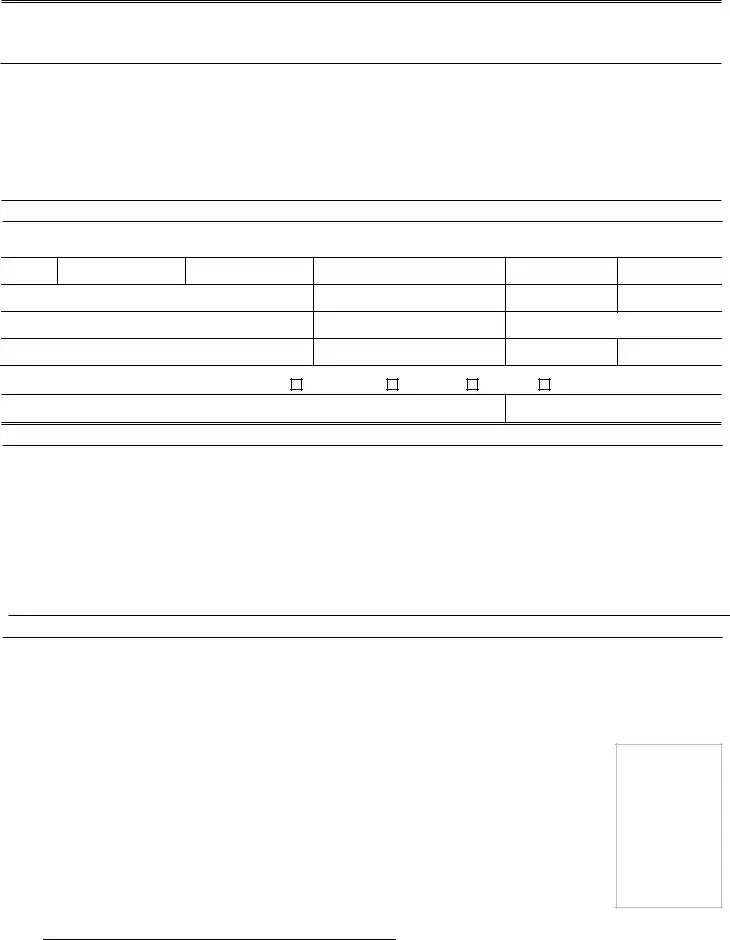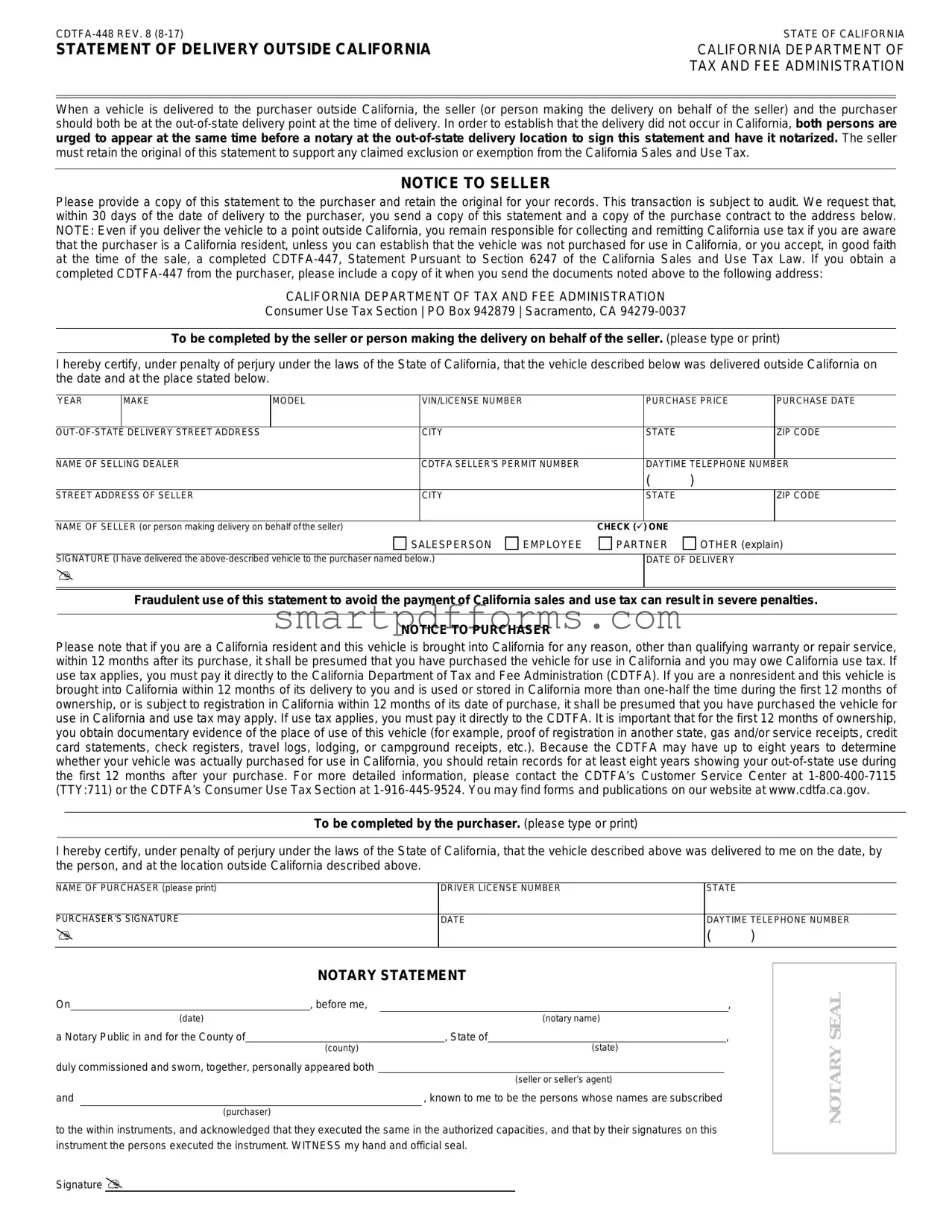
CDTFA-448 REV. 8 (8-17) |
STATE OF CALIFORNIA |
STATEMENT OF DELIVERY OUTSIDE CALIFORNIA |
CALIFORNIA DEPARTMENT OF |
|
TAX AND FEE ADMINISTRATION |
When a vehicle is delivered to the purchaser outside California, the seller (or person making the delivery on behalf of the seller) and the purchaser should both be at the out-of-state delivery point at the time of delivery. In order to establish that the delivery did not occur in California, both persons are urged to appear at the same time before a notary at the out-of-state delivery location to sign this statement and have it notarized. The seller
must retain the original of this statement to support any claimed exclusion or exemption from the California Sales and Use Tax.
NOTICE TO SELLER
Please provide a copy of this statement to the purchaser and retain the original for your records. This transaction is subject to audit. We request that, within 30 days of the date of delivery to the purchaser, you send a copy of this statement and a copy of the purchase contract to the address below. NOTE: Even if you deliver the vehicle to a point outside California, you remain responsible for collecting and remitting California use tax if you are aware that the purchaser is a California resident, unless you can establish that the vehicle was not purchased for use in California, or you accept, in good faith at the time of the sale, a completed CDTFA-447, Statement Pursuant to Section 6247 of the California Sales and Use Tax Law. If you obtain a completed CDTFA-447 from the purchaser, please include a copy of it when you send the documents noted above to the following address:
CALIFORNIA DEPARTMENT OF TAX AND FEE ADMINISTRATION
Consumer Use Tax Section | PO Box 942879 | Sacramento, CA 94279-0037
To be completed by the seller or person making the delivery on behalf of the seller. (please type or print)
I hereby certify, under penalty of perjury under the laws of the State of California, that the vehicle described below was delivered outside California on the date and at the place stated below.
YEAR |
MAKE |
MODEL |
VIN/LICENSE NUMBER |
PURCHASE PRICE |
PURCHASE DATE |
OUT-OF-STATE DELIVERY STREET ADDRESS |
|
CITY |
STATE |
|
ZIP CODE |
NAME OF SELLING DEALER |
|
CDTFA SELLER’S PERMIT NUMBER |
DAYTIME TELEPHONE NUMBER |
|
|
|
|
( |
) |
|
STREET ADDRESS OF SELLER |
|
CITY |
STATE |
|
ZIP CODE |
NAME OF SELLER (or person making delivery on behalf of the seller)
SIGNATURE (I have delivered the above-described vehicle to the purchaser named below.)
Fraudulent use of this statement to avoid the payment of California sales and use tax can result in severe penalties.
NOTICE TO PURCHASER
Please note that if you are a California resident and this vehicle is brought into California for any reason, other than qualifying warranty or repair service, within 12 months after its purchase, it shall be presumed that you have purchased the vehicle for use in California and you may owe California use tax. If use tax applies, you must pay it directly to the California Department of Tax and Fee Administration (CDTFA). If you are a nonresident and this vehicle is brought into California within 12 months of its delivery to you and is used or stored in California more than one-half the time during the first 12 months of ownership, or is subject to registration in California within 12 months of its date of purchase, it shall be presumed that you have purchased the vehicle for use in California and use tax may apply. If use tax applies, you must pay it directly to the CDTFA. It is important that for the first 12 months of ownership, you obtain documentary evidence of the place of use of this vehicle (for example, proof of registration in another state, gas and/or service receipts, credit card statements, check registers, travel logs, lodging, or campground receipts, etc.). Because the CDTFA may have up to eight years to determine whether your vehicle was actually purchased for use in California, you should retain records for at least eight years showing your out-of-state use during the first 12 months after your purchase. For more detailed information, please contact the CDTFA’s Customer Service Center at 1-800-400-7115 (TTY:711) or the CDTFA’s Consumer Use Tax Section at 1-916-445-9524. You may find forms and publications on our website at www.cdtfa.ca.gov.
To be completed by the purchaser. (please type or print)
I hereby certify, under penalty of perjury under the laws of the State of California, that the vehicle described above was delivered to me on the date, by the person, and at the location outside California described above.
NAME OF PURCHASER (please print) |
DRIVER LICENSE NUMBER |
STATE |
|
|
|
|
|
|
PURCHASER’S SIGNATURE |
DATE |
DAYTIME TELEPHONE NUMBER |
|
|
( |
) |
|
NOTARY STATEMENT
On |
, before me, |
|
|
|
|
|
, |
|
|
(date) |
|
|
|
|
|
|
|
|
|
|
|
|
|
(notary name) |
|
|
a Notary Public in and for the County of |
|
|
|
, State of |
, |
|
|
|
|
(county) |
|
|
|
(state) |
|
|
duly commissioned and sworn, together, personally appeared both |
|
|
|
|
|
|
|
|
|
|
|
|
|
|
|
(seller or seller’s agent) |
|
|
and |
|
|
, known to me to be the persons whose names are subscribed |
|
|
|
|
(purchaser) |
|
|
|
|
|
|
|
|
to the within instruments, and acknowledged that they executed the same in the authorized capacities, and that by their signatures on this instrument the persons executed the instrument. WITNESS my hand and official seal.
Signature

